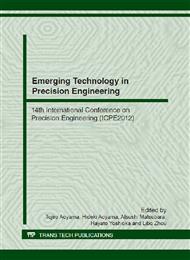p.793
p.799
p.805
p.809
p.815
p.821
p.826
p.832
p.836
Development of a Cutting Tool with Micro Built-In Thermocouples - Characteristic of the Micro Cu/Ni Thermocouples Fabricated by Electroless Plating and Electro Plating
Abstract:
This study has devised a tool insert with micro built-in thermocouples in order to establish a cutting-temperature measuring method for practical use. This tool insert possesses seven pairs of micro Cu/Ni film thermocouple near the cutting edge on the rake face. In this study, Cu film and Ni film were deposited in the micro grooves corresponding to a circuit pattern of the micro thermocouple by means of electroless plating and electroplating. This paper shows the results of the investigation concerning the electrical properties of the micro Cu/Ni film thermocouples. The influence of the current density in electroplating on the electrical resistivity of the films was examined. The characteristic of the Seebeck property of the micro Cu/Ni film thermocouple was investigated in a temperature difference of up to 600 K with a heating apparatus developed. The Seebeck coefficient of the micro Cu/Ni film thermocouple was smaller by 28 % than that of a Cu/Ni wire thermocouple. The result implies that the degradation in the Seebeck property of the micro Cu/Ni film thermocouple derives from an existence of an impurity between Cu film and Ni film in the hot junction.
Info:
Periodical:
Pages:
815-820
Citation:
Online since:
November 2012
Authors:
Price:
Сopyright:
© 2012 Trans Tech Publications Ltd. All Rights Reserved
Share:
Citation:


